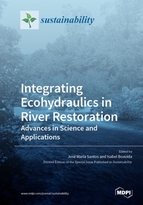Integrating Ecohydraulics in River Restoration: Advances in Science and Applications
A special issue of Sustainability (ISSN 2071-1050). This special issue belongs to the section "Environmental Sustainability and Applications".
Deadline for manuscript submissions: closed (31 May 2019) | Viewed by 53819
Special Issue Editors
Interests: freshwater fish; fish passage; ecohydraulics; fish migration; connectivity; river restoration
Special Issues, Collections and Topics in MDPI journals
Interests: ecohydraulics; freshwater habitat modelling; freshwater fish; sustainability
Special Issues, Collections and Topics in MDPI journals
Special Issue Information
Dear Colleagues,
Rivers have been intensively degraded due to increasing anthropogenic impacts from a growing population in a continuously-developing world. Conflict demands on freshwater resources, exacerbated by climate change, present a difficult dilemma for scientists and managers: Until when and how much can a river (and its natural flow regime) be altered while still maintaining processes and functions, and guaranteeing sustainable aquatic populations? Accordingly, most rivers in the world have been suffering pressures resulting from increasing dam and weir construction, habitat degradation, flow regulation, water pollution/abstraction and spread of invasive species. In addition, it is expected that global warming will further stimulate conflicts in water use leading to disturbances in river ecosystems. Science-based knowledge regarding solutions (e.g., environmental flows, dam removal, improvement of fish passes, adoption of fish-friendly hydropower solutions, riparian vegetation management, etc.) to counteract the effects of river degradation, and melding principles of aquatic ecology and engineering hydraulics, is thus urgently needed to guide present and future river restoration actions. This Special Issue of Sustainability aims to compile new information on fundamental scientific research and applications regarding the integration of ecohydraulics in river restoration (see keyword research topics below), ranging from field studies to laboratory experiments that have application to real-world challenges. Papers selected for this Special Issue will be subject to a rigorous peer-review procedure with the aim of rapid and wide dissemination of results.
Dr. José Maria Santos
Dr. Isabel Boavida
Guest Editors
Manuscript Submission Information
Manuscripts should be submitted online at www.mdpi.com by registering and logging in to this website. Once you are registered, click here to go to the submission form. Manuscripts can be submitted until the deadline. All submissions that pass pre-check are peer-reviewed. Accepted papers will be published continuously in the journal (as soon as accepted) and will be listed together on the special issue website. Research articles, review articles as well as short communications are invited. For planned papers, a title and short abstract (about 100 words) can be sent to the Editorial Office for announcement on this website.
Submitted manuscripts should not have been published previously, nor be under consideration for publication elsewhere (except conference proceedings papers). All manuscripts are thoroughly refereed through a single-blind peer-review process. A guide for authors and other relevant information for submission of manuscripts is available on the Instructions for Authors page. Sustainability is an international peer-reviewed open access semimonthly journal published by MDPI.
Please visit the Instructions for Authors page before submitting a manuscript. The Article Processing Charge (APC) for publication in this open access journal is 2400 CHF (Swiss Francs). Submitted papers should be well formatted and use good English. Authors may use MDPI's English editing service prior to publication or during author revisions.
Keywords
- Dam/weir retrofitting and removal
- Environmental flows
- Riparian and aquatic vegetation dynamics
- Fish passage and migration
- Sustainable hydropower
- Prioritization of river connectivity for sustainable fisheries
- Spawning grounds
- Habitat modeling
- Invasive species management







